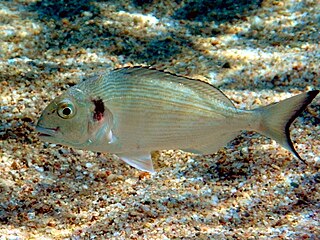Photobacterium damselae subsp. piscicida is a gram-negative rod-shaped bacterium that causes disease in fish.

The gilt-head (sea) bream is a fish of the bream family Sparidae found in the Mediterranean Sea and the eastern coastal regions of the North Atlantic Ocean. It commonly reaches about 35 centimetres (1.15 ft) in length, but may reach 70 cm (2.3 ft) and weigh up to about 7.36 kilograms (16.2 lb).

The Missolonghi-Aitoliko lagoons complex is located in the north part of the Gulf of Patras in the central west coast of Greece. It is one of the most important Mediterranean lagoons. It is a shallow area of 150 km2, extended between the Acheloos and Evinos rivers. It is protected by the Ramsar Convention and it is also included in the Natura 2000 network.
Pharmacotoxicology entails the study of the consequences of toxic exposure to pharmaceutical drugs and agents in the health care field. The field of pharmacotoxicology also involves the treatment and prevention of pharmaceutically induced side effects. Pharmacotoxicology can be separated into two different categories: pharmacodynamics, and pharmacokinetics.
Paramoeba is a genus of common parasites, including species that can cause infection in fish, crabs, sea urchins and others.
Ceratomyxa is a genus of myxozoan.

Acanthopagrus is a genus of fish in the family Sparidae found in the Indian and western Pacific Oceans.
Tuna penning is a practice used in marine aquaculture, in which smaller tuna are caught off shore and moved back to large, in-water enclosures. The pens are typically located in the relatively shallow waters of sheltered areas, such as bays or coves. Tuna penning is primarily used for Atlantic Bluefin Tuna (ABT), a highly profitable stock for the global fish market. The tuna caught for penning are typically caught between May and July by purse-seine vessels, and then transported back to pens, where they are fattened until October–January before being frozen and shipped out. While in the pens, the tuna are fed primarily fresh fish, such as sardines, squid, and mackerel. In the past decade, tuna penning has become a large sector within the fish aquaculture industry, and takes place primarily in the Mediterranean. In 2010, ABT constituted 8% of global fish exports, the majority of which was shipped to Japan. Tuna penning is regulated by the International Commission for the Conservation of Atlantic Tunas (ICCAT), and each farm is required to register both the number of tuna it has and the total capacity of the farm.
Ceratomyxa brayi is a species of myxosporean parasites that infect gall-bladders of serranid fishes from the Great Barrier Reef. It was first found on Cephalopholis boenak.
Ceratomyxa gleesoni is a myxosporean parasite that infects gall-bladders of serranid fishes from the Great Barrier Reef. It was first found on Plectropomus leopardus.
Ceratomyxa hooperi is a myxosporean parasite that infects gall-bladders of serranid fishes from the Great Barrier Reef. It was first found on Epinephelus quoyanus.
Ceratomyxa nolani is a myxosporean parasite that infects gall-bladders of serranid fishes from the Great Barrier Reef. It was first found on Epinephelus quoyanus.
Ceratomyxa whippsi is a myxosporean parasite that infects gall-bladders of serranid fishes from the Great Barrier Reef. It was first found on Cephalopholis boenak.
Ceratomyxa yokoyamai is a myxosporean parasite that infects gall-bladders of serranid fishes from the Great Barrier Reef. It was first found on Epinephelus maculatus.
Tenacibaculum is a Gram-negative and motile bacterial genus from the family of Flavobacteriaceae.

Sparicotyle chrysophrii is a species of monogenean, parasitic on the gills of the marine fish. It belongs to the family Microcotylidae. Its type-host is the gilt-head seabream.

Enteromyxum leei is a species of myxozoan, histozoic parasite that infects the intestinal tract and sometimes associated organs, like gall bladder and liver, of several teleostean fish species. Myxozoans are microscopic metazoans, with an obligate parasitic life-style. The parasite stages of this species live in the paracelullar space between fish enterocytes. It is the causative agent of enteromyxosis, or emaciative disease, also known as "razor blade syndrome" in sparid fish. E. leei has a wide host and geographical range within marine fish, and even freshwater fish have been infected experimentally. E. leei initially emerged in the Mediterranean in the late 1980s and it is believed to have been unintentionally introduced into the Red Sea. Its pathogenicity and economic impact depend on the host species. In the gilt-head seabream, it is manifested as a chronic disease that provokes anorexia, delayed growth with weight loss, cachexia, reduced marketability and increased mortality. In other species, it has no clinical signs. In sharpsnout seabream, infection results in very high mortality rates, which have pushed fish farmers to abandon the culture of this fish species.

Ceratothoa oestroides is a crustacean isopod, obligate ectoparasite of marine fish that dwells in the buccal cavity. It is the causative agent of various pathologies including tissue damage at the parasitisation site (tongue), growth defects, decrease in mean host weight and size and increases mortalities in farmed and wild fish populations. It has been recorded in six different fish families: Sparidae, Carangidae, Clupeidae, Maenidae, Scorpenidae, and Mugilidae.

Enterospora nucleophila is a microsporidian infecting the gilt-head bream. It develops primarily within the nuclei of rodlet cells and enterocytes, at the intestinal epithelium. It can also be found in cytoplasmic position within other cell types, including phagocytes, at subepithelial layers. It is the causative agent of emaciative microsporidiosis of gilthead sea bream, a chronic condition manifested as a severe growth arrestment, normally accompanied by trickling mortality.
Carlos José Correia de Azevedo is a Portuguese biologist specialising in microparasites of aquatic organisms, particularly Apicomplexa, Haplosporidia, Microsporidia, and Myxozoa.






